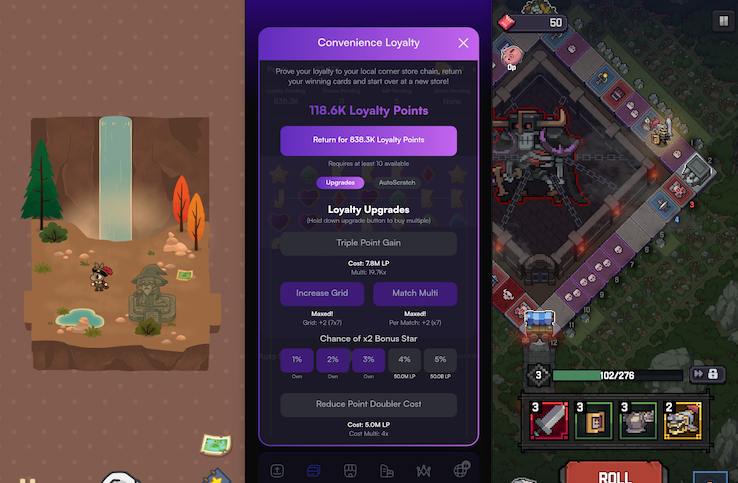
3 simple yet satisfying Android games: 🐰 A Tiny Sticker Tale, 🎰 Scratch Inc, 🎲 Heroll
A cosy adventure, a scratch card incremental, and a monopoly roguelite! What an odd collection of games, they’re all simple yet satisfying.
#1: A Tiny Sticker Tale
This is a very cozy metroidvania adventure / collecting game, with its Steam and Nintendo Switch origins explaining the high quality compared to other mobile games (and the one-off payment model)!
Screenshots
All screenshots are from version 1.1.15:
| Beach archery | Mountain waterfall | Secret cult |
|---|---|---|
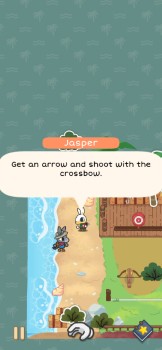 |
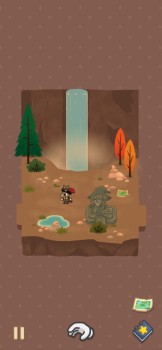 |
 |
| Full map | Example inventory | Sticker book |
|---|---|---|
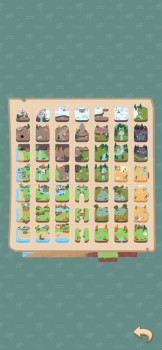 |
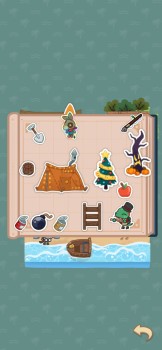 |
 |
Review
I absolutely love this game! I started it up, and didn’t move for ~2.5 hours until it was pretty much 100% completed. It has a very simple core concept, with all characters and many objects actually being “stickers”. This means you can pick them up, move them, put them in your inventory, take them somewhere else, etc.
This mechanic starts off very simply with just moving objects out of your way, and the game is clearly designed with it in mind. For example, a character might say “meet you at the top of the mountain”, you walk up there, then realise you forgot to put them in your backpack first! Oops!
Your inventory has a limited amount of space, with a bit of very retro “inventory tetris” sometimes needed to fit everything you want to carry around. You’ll quickly end up carrying a fishing rod, a bomb, a bridge, a crossbow, a character you know needs to go somewhere, a trophy you earned, it gets messy!
Whilst the overall story is very wholesome and sweet, it’s pretty straightforward and really just serves as a motivator to explore the intriguing island. There’s a swap, a desert, an ice area, a beach, everything you’d expect from an adventure game spread across almost 50 screens.
What makes the game so enjoyable to play is the metroidvania-y tactic of dripfeeding new features just when you’re starting to get bored, and regularly finding new uses for previous content. For example, a miner mentions he can’t see well enough to mine some rocks. Luckily you’ve unlocked a sun that changes the time of day! The miner then mines a gem, which can be used somewhere else to make bombs, which can then be used to unblock a passage that… you get the idea. Completing a puzzle unlocks something that unlocks a puzzle, over and over.
In addition to the “main” storyline, there’s optional side puzzles all over the place. For example, someone gave me a shovel, and I discovered the small cracks in the ground I kept seeing can actually be dug into! This reveals various treasure, like fairies that can be collected for a larger sticker inventory, or items that help solve puzzles.
You’ll spend your time essentially being on 3-4 quests at once, with each being scattered all around the map. This might be giving unique trees to a character that makes furniture, wondering how to lower a bridge, beating your antagonist at tennis, all without any indicators or quest list. I generally have a pretty poor memory, and it was sometimes tricky to remember where I left an item an hour ago, with the map’s limited size proving an advantage.
Later on, you’ll unlock a map, a sticker re-finder, a moveable tent home, and even a within-current-screen teleport, as well as various items to buy furniture, outfits, and Christmas / Halloween themed items.
By the time I’d had enough of the game it was around 95% completed, with the remaining work being hunting down one missing fairy (grrr), and picking up a few scenery items I’d never picked up. Each trophy / achievement feels earned, and they’re well paced to make each have real value.
Monetisation
A Tiny Sticker Tale is a one-time purchase of £3.79 (~$5), however I accessed it as part of Play Pass. It contains around 3 hours of high quality gameplay, with no additional monetisation or adverts.
Tips
- Carry your useful stuff with you! Fishing rod, bomb, shovel, a bug that plays music, stack them in your inventory as best you can.
- Wander around sometimes, early on I frequently took a wrong turn and ended up in a new screen!
- Don’t forget the sticker mechanic! I kept forgetting that bridges and ladders can be moved.
#2: Scratch Inc
I’ve never been interested in scratchcards, but I am very interested in well-made incrementals, and Scratch Inc combines these 2 things!
Screenshots
All screenshots are from version 1.1.06:
| Scratch card | Loyalty scheme | Store ownership | Settings |
|---|---|---|---|
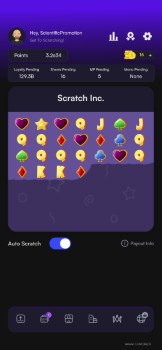 |
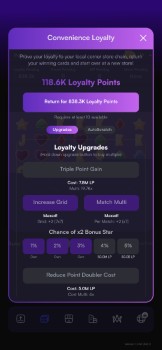 |
 |
 |
Review
The game is built around a simple central mechanic: playing scratch cards for money to upgrade earnings, card size, and multipliers. The complexity comes in what happens after you earn enough “loyalty” (through card completions) to “prestige” and earn loyalty points. This is the first layer of prestige.
After completing cards to earn store loyalty, you’ll eventually be able to prestige this to begin owning stores. You’ll eventually be able to prestige this to take over the overall scratch card market. You’ll eventually be able to prestige this to enter new markets. You’ll eventually be able to prestige this to begin again on other plants.
The point is… there are many layers of prestige. These resets are initially pretty brutal, losing almost everything, but each new layer of progress currency becomes extremely powerful. For example, it might multiply earnings, let you automate the purchasing of automations, etc.
I typically don’t enjoy games with aggressive prestige resets, but the game balance is very well implemented, so each prestige feels worth it but not overpowered. Additionally, the level of automation is extremely rewarding, so as you progress through the “layers” you eventually won’t even be looking at the first layer at all.
The game becomes more automated as it progresses, avoiding it ever feeling too grindy. I’ve currently completed my first monopoly reset, meaning (I think) I’m 5% of the way to leaving Earth. Whilst it took the entirety of my playtime so far (a few days) to get here, the snowballing effect means I doubt it’ll take more than another day or two!
Automating the purchasing of automation employees is a great way of adding meaningful upgrades to higher prestige levels without actually increasing complexity. It allows the game to scale to (at least) 6 prestige levels without ever deviating from the key concept of scratching cards for money. Everything else is just a wrapper around this, with the layers making logical sense.
Supporting this great game design is a clear and understandable UI, and consistent phrasing used to avoid confusion. The game in general feels “fair”, like it is genuinely just trying to provide a fun experience, not hassle you to pay up. This is reinforced by the (very optional) “Gold” currency, with the purchase screen even stating “The game has been balanced without [gold]”, and that this game is an after-work hobby not a job. This currency is also earned through achievements.
The result of this is a game that clearly prioritises player experience, including features such as a completely unnecessary (but appreciated) character customisation and name generator (in the format [adjective][noun], say hello to “ScientificPromotion”!). I’m currently rank ~1000 overall, and it’s fun seeing “WoefulEstimate”, “LiquidHour”, and “EmotionalDisaster” in the top 3 spots.
Monetisation
As mentioned, Scratch Inc has entirely optional gold purchases that can boost points, loyalty, grid size, multipliers, etc. Although almost any source of income can be multiplied, which would usually be seen as a downside, the fact it is entirely unnecessary (and any benefit would be quickly nullified by normal progress) makes this extremely fair.
The monetisation is perhaps a little too fair, as currently there is no real incentive for myself personally. After the basic purchases that are easily earned through normal gameplay, the first meaningful permanent upgrade is increasing grid size, at around £9 (~$12), far too much for the benefit provided.
Whilst I greatly appreciate a game with no adverts whatsoever that disincentivises payments, Scratch Inc is perhaps too far in this direction! I’m always happy to spend $2-5 on a game I review, but here there is seemingly no point.
Tips
- Increasing automation is almost always the correct choice.
- Across all prestiges, the “points” you earn increase in cost. For example 6% market share might take twice as much effort as 5% market share. This means prestiging earlier than normal earns you far more overall.
- Increasing grid size is one of the most powerful upgrades, always pick it!
- In the settings, I highly recommend turning off “90% scratch threshold” to make cards complete faster.
- I also recommend turning on “Transparent menus” so you can see your pending currencies whilst in a menu.
- There is a pretty active Discord, possibly because the developer also made Pincremental (which I didn’t enjoy!).
- Interestingly, you can see a far more basic and less appealing early version of the game on the developer’s store page!
#3: Heroll
Sometimes a simple game with a nice aesthetic can be all you need, in this case Heroll’s roguelite Monopoly-with-combat format is great for a sub-5 minute run!
Screenshots
All screenshots are from version 1.2.1:
| Main screen | Board | Combat | Minigame |
|---|---|---|---|
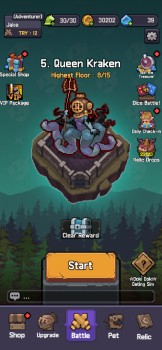 |
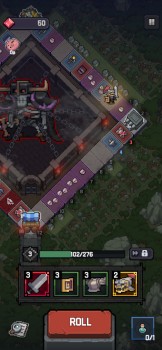 |
 |
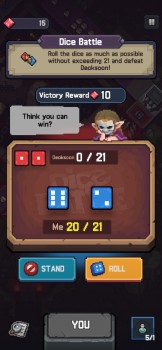 |
Review
As mentioned, this is basically Monopoly with enemies! Roll dice, land on a square, play a minigame or fight an enemy, and continue round and round until you or the boss dies. You’ll have all the roguelite staples such as random equipment drops, health potions, shops, as well at perks / pets / relics to upgrade between runs.
The game does a great job of adding complexity on top of this relatively simple idea, with plenty of minigames (e.g. Blackjack, tapping in time, etc) as you make your way around the board. Additionally, some tiles will activate area effects (e.g. changing the next row of tiles to chests), whilst the boss in the centre will continually output enemies and debuffs to hold back your progress.
Luckily, the actual gameplay is pretty simple. Roll the dice, then enter a battle where your only control is when to drink potions (if you have any!). If you win, you get some loot and can move on. If you lose, your run is over. Easy.
The equipment upgrades are fairly linear, with each “loop” around the board upgrading the enemy and equipment levels, meaning you’ll never stick with the same items for long. However, they’re all about the same so it isn’t too important, although it is nice seeing your character’s sprite updated.
There’s a solid variety of perks, stats, and effects available, with the shop offering interesting changes to the automatic combat. However, the same currency is used for health potions / potion upgrades as perks, so there’s an element of risk vs reward. Ultimately it’s impossible to predict if you’ll fight nothing or relentless max-strength monsters before your next shop, so staying fully stocked up is the only safe option.
Whilst a single run takes 5-10 minutes, they’re generally pretty easy (at least the first 4-5 bosses that I’ve experienced) unless you get very bad luck. This makes the energy system particularly pointless, since it’s recharged by the time you’ve finished your run, and holds enough for 5-6 runs! Mine was never less than 85% full.
There are some odd choices of obvious engagement tricks utilised, which leave a bit of a nasty taste in the app. For example there’s a standard daily reward system, but this is represented as “Deoksoon’s affection”, a female character wearing a maid outfit, seemingly with no relation to the actual game. There’s also a daily “lucky wheel”, a Pachinko based relics system, a bizarre spammy global chat, lootboxes etc, all a bit excessive and unnecessary.
In summary, Heroll is a solid game for a few minutes of simple yet satisfying gameplay, with an attractive and responsive UI. I’m probably not too interested in “finishing” it, and it’s very repetitive and luck dependant, yet is a solid candidate for something to mostly pay attention to whilst watching TV or listening to a podcast.
Monetisation
As mentioned, there’s a lot of engagement and monetisation strategies in play, but the game does a fairly good job of keeping these out of the actual gameplay. Instead, they’re all crammed in the mess that is between rounds, where 10 things try to grab your attention and get your money / ad view! The end result is I ignore it all, upgrade my equipment, and just dive back into the actually good bit of Heroll: the gameplay.
So, there’s purchaseable “diamonds”, used for gold (upgrades) and energy (playtime), buying misc perks / pets from the shop, opening pet lootboxes, as well as all the typical “packages” with various items inside. I’ve no intention of buying any of it, since the gameplay seems fairly simple, and the purchaseable perks just save time.
Tips
The game is almost entirely luck based, so there aren’t many tips!
- Save your potions until you’re low, but not too low health, since you’ll often gain health naturally.
- Any items that give you lifesteal / heal on battle end will be extremely powerful, since any passive restoration is very useful.
- A higher number equipment isn’t necessarily better, especially if the current equipment has a decent perk on top.
- You should spend all your money at the shop when you can, since there’s no benefit in saving up. I found buying the passive perk best, followed by improving health potion capacity / effect.
- You can earn health potions above your maximum, but it’s still worth having the capacity.
Past games
- I got Worms: I continued checking in on this once or twice a day for a few weeks and buying all. When I wrote the review I had ~200/1567 upgrades purchased, I now have 1438/1567, although the last few upgrades and achievements do look a little too time-consuming to be appealing. Still, there’s a decent chance I’ll come back to it now and then.
- Dig-Dig Rush: Okay, I got really into Dig-Dig Rush after writing my review. Whilst the gameplay hasn’t changed much, there’s something deeply satisfying in spending 20 minutes watching numbers go up every morning! I eventually purchased the £10 (~$13) ad-free pack, permanently granting all the advert bonuses. This means lots of free items, free dungeon attempts, free speed-ups etc. I’m up to level 358, rank Prince 2, and suspect I’ve run out of new content.